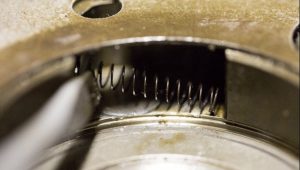To use – or not to use – synthetic oil in engines made decades before synthetic oils were in common use . . . that’s the question!
And there are several answers.
I just discovered one such – I think – by stumbling into it (figuratively).
One of my old rigs is a 1983 Honda GL650 Interstate, which was – for one year – a kind of little brother to the same-year Honda Goldwing. It’s a curious Honda in that it is not powered by an inline (or flat) four but rather a slightly off-center – or “twisted” twin. It’s got a pushrod-actuated valvetrain and a 9,000 RPM redline, which is a pretty interesting combo just by itself.
Anyhow, I ride this bike a lot because of all my bikes, it’s the most practical. It has the full Goldwing fairing, so lots of wind/weather protection and lots of storage, which is helpful when you need to cart more than just you around. But it’s hard to ride when your bike won’t start – not because it needs a tune, but because the starter clutch seems to be failing.
That seemed to be happening beginning a few months ago, at the start of the riding season. I’d push the starter button and instead of the starter turning, a sickly whirring – the sound of the starter clutch slipping. This happens when the little springs inside the clutch either fail and break or fatigue such that they lose their former necessary tension and can no longer engage the clutch, which slips . . . enter the whirrs.
Now, these three little springs – new replacements – only cost about $15 for the kit. But to install them entails removing the engine from the bike. This is Step One. It is one of the few things about this ’83 Honda that hasn’t made me pat it on the tank. Huge hassle, especially when your garage is overflowing with other stuff and finding room – and time – to tear down a bike seems almost as challenging as explaining to a “masker” the illogic of him demanding others wear them if his “works” as he insists it does.
So I figured I was on borrowed time – and might as well make the most of what remained, by riding the bike until the starter clutch failed completely and starting the bike became an impossibility. Or at least, impracticable. Roll-starting is always possible with a bike – but that requires a hill to roll down. Or someone strong to push you from behind to get a rolling start. Or a kick starter, which this particular bike does not have.
I also figured I probably ought to change the oil and filter while I still can. Or rather, change it after the engine had been started and warmed up, which is preferable to changing it when the engine’s cold because the oil drains faster and the stuff you want out of the sump isn’t settled in the bottom of the sump and less likely to drain completely.
Well – and here’s the punchline to this story – I had been using synthetic oil in this 40-year-old Honda’s engine. But when I went to get a fresh jug at the bike store, they were out of my usual. So I got a jug of Honda-brand non-synthetic, thinking it’s fresh oil and that’s what matters most.
As it turned out, other things may have mattered more.
After having changed the oil – from synthetic to conventional – the starter clutch seemed to have heeeeeaaaaauuhld itself, Ernest Angley-style. When I pushed the button to start the bike, the starter turned – rather than slipped. No more whirrrrr!
The engine started.
It has done so without interruption since I reverted back to the kind of oil that was specified for this engine by Honda back in the early ’80s. Maybe the problem with the slipping starter clutch was due to the synthetic being more slippery than conventional oil. Maybe it had to do with the synthetic being a different (lighter) viscosity.
Maybe both.
All I know – for certain – is that since I went back to the type (and weight) of oil that Honda put into this engine when it was new, 40 years ago, the slipping starter clutch problem – the only mechanical problem I have ever had with this 40-year-old bike that I have owned for more than 15 years – is no longer a problem. It appears the problem had been created by the use of too light/too slippery oil – and solved by not doing that anymore.
I’m grateful to the Motor Gods, at any rate – because I can ride the bike rather than pull the engine in order to replace three $15 springs!
. . .
If you like what you’ve found here please consider supporting EPautos.
We depend on you to keep the wheels turning!
Our donate button is here.
If you prefer not to use PayPal, our mailing address is:
EPautos
721 Hummingbird Lane SE
Copper Hill, VA 24079
PS: Get an EPautos magnet or sticker or coaster in return for a $20 or more one-time donation or a $10 or more monthly recurring donation. (Please be sure to tell us you want a magnet or sticker or coaster – and also, provide an address, so we know where to mail the thing!)
If you like items like the Keeeeeeev T shirt pictured below, you can find that and more at the EPautos store!












Those are great engines and the 650 is the larger displacement of the design. A Guzzi layout but water cooled and built around the best period of Japanese production. I was after one for awhile but stumbled into a 06 Wee Strom and couldn’t pass up the deal. Another fantastic bike and one of the best ever. To date I’ve never had any drama running full syn Rotella 15-40 in everything I own. Trucks, cars, bikes, even lawn mowers. In fact I think engines in general last longer last longer and so does the oil if need be. I consider it a superior product to most all. But these water weight super thin 0-10w modern oils are definitely a no-no. No doubt they are great on cold startup but that’s about it at least in older equipment. Great to hear that the thicker oil cured the issue. Just imagine if you had split it replaced the springs and found it still exist. Enjoy the ride!!
Hi DD,
I have nothing other than good things to say about my ’83 GL650. The thing remains as reliable as taxes but far more enjoyable. And no issues with the starter clutch not engaging after going back to conventional 10w-30 Honda oil in the jug.
For what it’s worth and without commenting on the oil, I’ve had the same problem show up on 2 older Gold Wings. After sitting inside for 4-5 months of Midwest winter that starter clutch will refuse to engage. Once they are run and warmed up it goes away until next spring. I’ve done stuff like spray/dribble in wd40 or Marvel Mystery Oil and some judicious tapping in the vicinity to get them to grab enough to start.
I run synthetic in all my newer stuff, but just am not willing to try it in something like a 8ba flathead, that stuff was designed for straight 30w and allowed for 20 or 10w in extreme cold. In the late 70s and early 80s I took dads advice and ran 10w40 in everything except in hopped up air cooled VWs and bikes we ran Castrol 20w50. But in the late 70s nobody really expected an engine to run much over 100k without an overhaul.
Hi Ernie,
Yup!
All I can say for certain is my Silverwing starts normally again, Even in the cold. And the only variable is the oil – changed back to Honda 10w-30 (as specified by Honda for this bike). I’ll stick with it forever more!
Thinking back to the 80s when Mobil 1 became a new trendy thing I recall my GoldWing 1000 idling faster after its first charge of synthetic oil. Did you idle speed/ clutch action change when putting in the conventional stuff?
Hi Torino,
I haven’t noticed any difference in re idling or clutch engagement. But the starter clutch “problem” is definitely solved!
Great and timely article for me Eric! Thanks! (Stick with me a minute Eric as I may have 1-2 future article ideas for you in this response.)
I have been thinking of changing to synthetic because I recently moved to Alaska and am working a job that requires me to commute with my own vehicle (I have had the luxury of a company provided vehicle the last 22 years and am working on getting back into that situation).
I have put more miles on my truck the last 6 months than I have the last 5.5 years of ownership prior. But that’s what happens when you drive from the Southern US across two countries to get to Alaska.
I have already had 2 oil changes since arriving. For the past 5 years I have been changing once a year because I was doing 3-5k per year. I’m “supposedly” due for an oil change again. Argghh!
Since I have been in charge of keeping my employers’ vehicles maintained, I have been an every 5k person since that is what the companies I worked for required for maintenance. Now that I’m due again, I started thinking about any advantages synthetic may bring to the table. Enter your article.
I have a ’12 Taco that I got with 43K on the clock. It’s my “forever truck” barring something bad happening. Once a year I would get an oil change and replace with dino oil. To me, low mileage didn’t matter, I replaced once a year because I had heard that oil breaks down. Keep it fresh. However; I’m looking at my 4th oil change in one year and synthetic started sounding better.
Now that I have read your article, I did some research but also am left wondering until I can research more on my own.
1. In my initial research, I came across a fellow who seems very knowledgeable about motors and oil. This person said that the Jiffy Lubes of the world have convinced the average person that they should change oil every 3k/once a year, whichever comes first. This is simply not true. This person did not comment on the 1 year interval, but did for the mileage intervals. 3k for dino oil is bogus (But!!!, comes below), and that the 5k interval in which I have become accustomed is for “severe duty”. Which makes sense for a company vehicle that is daily driven 5k PER MONTH. The actual replacement time for an “average” vehicle running dino is really around 7.5k.
2. But!!!! I had a neighbor who was a mechanic for a long while who said the problem with synthetic isn’t because its better, its because the frequency of oil changes is longer. If one has an oil leak and isn’t conditioned to regularly check their oil like us older folks, they may run their engine dry before their next oil change. And another But!!! People might have leaks and NOT know it. Neighbor mechanic said a lot of Mercedes usually have a carpet mounted underneath the engine to absorb oil leaks. Can’t be leaking on a rich man’s garage if you want him to pay top dollar, but, a rich man can afford to be ignorant and drive around with an oil soaked carpet weighing the vehicle down.
3. If there is an advantage to synthetic in the Frozen North, I would be interested in knowing about it. Flip side is me looking at the EVs in Anchorage. Virtue signalling to the max. It’s already almost colder than a witch’s nipple here. Within the next couple of months, I’m betting I don’t see a Tesla anywhere on the roads. Studded winter tires are allowed here during winter. I have yet to hear a Tesla running on studded tires. It hasn’t snowed yet here, but I can clearly observe that pretty much everyone is already ready for the winter weather. The hondas, acuras, etc, they are already running studs because they don’t have 4WD or AWD. I suspect the Tesla people are about to go back home to the lower 48.
Morning, J!
One of the chief advantages of synthetic is that it flows more readily in very cold weather, easing start-ups on cold mornings and also improving lubrication at start-up. It is also better able to protect when the engine is running hot and or operating under extreme loads. Many new vehicles are factory filled with synthetic, especially models with turbocharged engines.
My advice would be to use the type/viscosity oil recommended by Toyota absent some goof reason (such as extreme cold conditions) to use something else!
Interesting.
Since I’m not burdened with any actual knowledge (cough, cough), I’ll feel free to share a feeble thought. It seems unlikely, to me, that the operation of the starter clutch depends on the exact lubricity of the engine oil. However, that viscosity thing: that seems much more significant than normal-or-synthetic. I don’t think anyone is well-advised to use oil of a different viscosity range from what the manufacturer calls out. That sounds a bit chancy.
Interesting revelation about synthetic oils. Never argue with success.
https://www.sae.org/
The Society of Automotive Engineers want to advance mobility knowledge, their mission statement: Our Mission is to advance mobility knowledge and solutions for the benefit of humanity.
Ethanol included in most gas now is causing problems in older engines….
WHY ETHANOL IS AN ENGINE KILLER
https://www.walbro.com/why-ethanol-is-an-engine-killer/
If you drive a classic car, especially one designed for leaded gasoline, avoid ethanol like the plague. Running one of these old engines with unleaded fuel is hard enough on the valve seats—and dumping ethanol in the mix would be like striking them with a hammer.
https://www.junkyardmob.com/misc/why-is-ethanol-bad-for-cars
A new business opportunity?
How to Remove Ethanol from Gas
https://www.wikihow.com/Remove-Ethanol-from-Gas
The pisser would have been all that work to finally open it up and find three intact springy springs!
I found out the hard way to ONLY use the oil specified. My first bike was a 1972 Honda CB450, and the hype back in the day “run 20w50 in your bikes”. Honda said 10w40. It came home from northern CA in the back of a truck when it ate a crank bearing. Also my first experience tearing down a motor completely. The new crank kit from Honda was $165 in 1973 dollars, owch when your lucky to earn $1.85 an hour.
I had several helpful folks along the way. The local Honda dealer helped twice, once to open the cam drive chain and again to close it up when I got the motor back together. The other was the owner of my hometown NAPA, he convinced me to re ring it while apart and he did a great glaze break cross hatch on the cylinders for just a couple bucks.
Drove it another six years zero problems, zero leaks a great learning experience. Oh and it got ONLY Valvoline 10w40 after the rebuild! 10w flows where it belongs much quicker than 20w and even hot, that motor oiling system including passage diameters is designed for the specific weight oil.
Same problem with some transmissions or transaxles…if the lubricant is too slippery the syncros won’t grab and work as well
Same with some engines after rebuild….synthetic oil is too slippery….so parts won’t break in/seat properly….
I made the mistake of using synthetic in a 20-year old bike and within about 50 miles the clutch starting slipping and chattering. I think you’re right. The oil was too slippery for the wet clutch.
Had the same problem on my GL650,,, difference is starter still failed after the rebuild. An old Honda Mechanic suggested I go to Dino oil. Fixed the problem. Also, if you end up pulling the engine change out the stator and be sure to have the tools to replace the mechanical seal. And talk about a rocket. I removed the super heavy fairing. Wow… It would lift the front wheel. I do miss it.
I am experiencing some health issues at age 74 so I sold it but I have several boxes of spare parts, heads, valves etc,,, most from ebay,,, couple gas tanks, cables and a set of rebuilt carbs (ready to go). If you are interested let me know.
I’m glad it worked out for you Eric. It gets harder to maintain older bikes when parts are no longer available. Recently, the FI light started coming on on my 18 year old 87k mile Honda ST1300. Per my research so far, many times fixing it requires replacing the ECU, and I found out that it’s no longer available from Honda so I’ll have to take my chances with finding a used one.
Hi Robbie!
Thanks – and – sorry to hear about your ST1300. This is why I stay away from bikes with FI and other such. I keep bikes forever and modern bikes with modern EFI and related electronics are (like modern cars) designed to work well for about 12-15 years and then you get another one – because fixing them becomes too expensive to too difficult.
I have a ’76 Kz900 that can be rebuilt effectively forever.
The Harley dealers around Seattle got snooty and refused to work on older Harleys especially Shovelheads. Their own product! Lazy F’s. At the time it wasn’t related to parts availability either. Then started refusing trades older than 10 years or 50k miles.
Using old school oil is extremely important especially with older engines. I have a 69 Datsun 2000 sports roadster and (2) British bikes: BSA and Norton. My Datsun’s rear main seal is the old rope type that is fitted into the crank main bearing. Synthethic oil will find a way to leak thru this old seal and then you have a *path* created and a leak until you decide to overall the engine. There is always some leakage but synthetic is not kind to old engines. Also, the zinc is required for maintaining lube metal to metal contact surfaces.
Throw it in the woods.
Old engines with flat tappets need the high zinc oil….
You know what this means don’t you? The engineers who built the thing actually knew what they were doing!
“Use this oil.”
“Eh, that’s just a suggestion. This stuff says it’s oilier.”
Similar problem to the 77′ Moto guzzi lm1 for the same reason- I had to pull the engine to fit a new clutch, and the thing opens like a clam shell. Twisted twin issues, the downside.
Eric, I heard a lot of good things about that bike on shadetree surgeon’s channel
He does a funny little (regular car reviews style) review 2:50 in https://www.youtube.com/watch?v=fC_hz13sHJQ
on his cross country ride with one.
That was a fun video to watch, Anchar – thanks!
And it shows how stout these bikes are. How many 40-year-old $1,200 bikes will take you across the country, running near redline most of the way?
Exactly- honda and japanese rpm capability is always impressive to me. I can tell you from experience an 86 harley with a 1340 evo will drop a horn, heat shield, break exhaust studs, let the oil filter drop and hang by the hoses…all under 5000 rpm on just day trips. Got to keep plenty of zip ties handy on the road.
The guy in the video also rode a shovelhead from oregon to florida, and he had many more issues. The bike looked great when he got it and was a clapped out POS by florida and he was using wood chips or his thumb to keep oil in the head since the bolts left
Re Shovelhead touring, not for the faint of heart or those not blessed with mechanical aptitude. We headed out from south Seattle to Sturgis all on newer EVOs but one bud and his wife on an aging Shovel. Midway thru day two it got over 95 and his in line fuel filter caused a vapor lock, pitched that all well till it got near 100 later on. No way he was going to make it fully loaded. Transferred the wife to my Electraglide (luxury seating, pillow like backrest for her). She rode with me for another 10 days and no more Shovelhead issues.
Another trip his beloved Shovelhead “Lucille” snapped a muffler hanger far from home. I quickly ginned up a theme song “you picked a fine time to breakdown Lucille, two hundred miles from home it’s one hell of a deal”. He wasn’t amused. Lucky we were in a town and the local garage welded it up.
My philosophy has always been to follow the manufacturers recommendations. They designed and built the thing after all, they should know best.
I’ve been using Castrol 10w40 in my Kawasaki for over 20 years now with about 70,000 miles on her with no problems. The only thing I’ve got currently running synthetic is the snow blower… Funny thing is that you can find synthetic motor oil now costing almost the same as conventional oil and I wonder when I’ll be making the switch over in my cars.